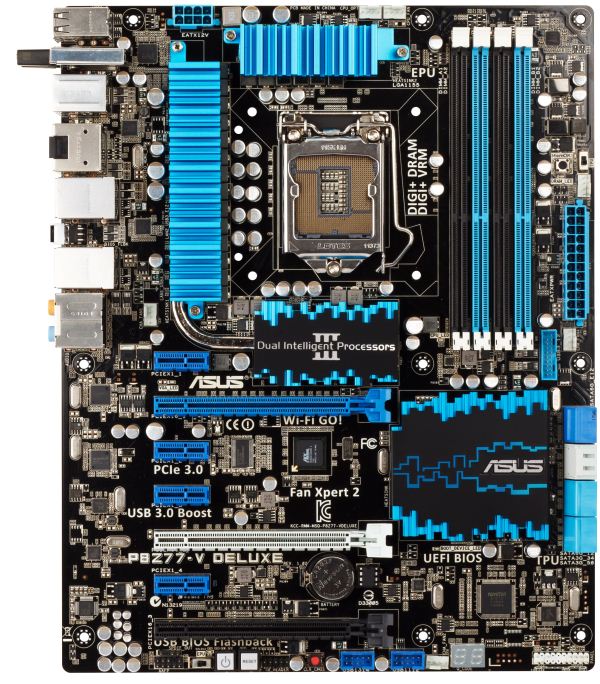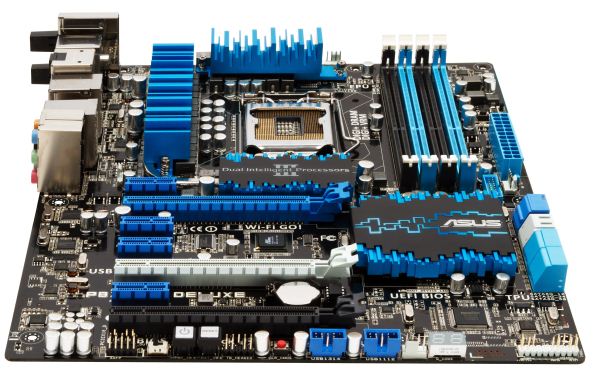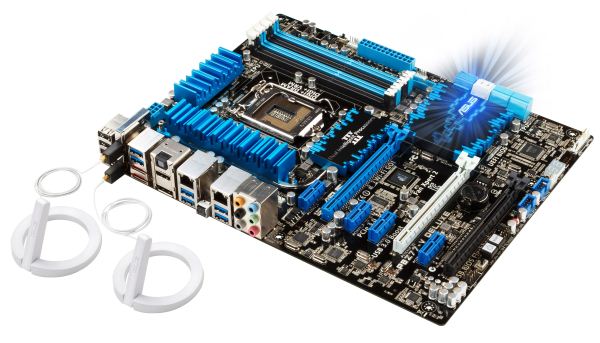Intel Z77 Panther Point Chipset and Motherboard Preview – ASRock, ASUS, Gigabyte, MSI, ECS and Biostar
by Ian Cutress on April 8, 2012 12:00 AM EST- Posted in
- Motherboards
- Intel
- Biostar
- MSI
- Gigabyte
- ASRock
- Asus
- Ivy Bridge
- ECS
- Z77
ASUS P8Z77-V Deluxe—Visual Inspection
In the next notch up in the channel board segregation, ASUS sell the Deluxe. This will be the first ASUS Deluxe board we have reviewed at AnandTech since the Llano mini-ITX F1A75-I Deluxe last year. In comparison to the P8Z77-V Pro, the Deluxe features several upgrades in terms of functionality and comfort.
The first to note is the increased power delivery to the CPU—this time in the form of a 16 + 4 phase power delivery. As a result, the VRM heatsinks to the left of the CPU are directly connected via a heatpipe to another heatsink below the socket. Also on board are the ‘enthusiast’ power/reset buttons and two-digit debug that we did not see on the Pro, and the use of dual NICs on the I/O, in the form of an Intel 82579V and a Realtek 8111F.
Due to the positioning off the heatsinks on the Deluxe compared to the Pro, the socket area seems a bit smaller (for example, the left hand heatsink is moved further in towards the socket), meaning that big air coolers may have a tougher time if they do not fit into Intel’s socket specification. Around the socket itself, we still have access to five fan headers—two 4-pin on the top of the board, one 4-pin to the bottom left of the main VRM heatsink, and one 4-pin either side of the 24-pin ATX power connector. A sixth fan header on board is found at the bottom next to the two-digit debug output.
Above the main power connector on the right hand side are the MemOK button and the TPU switch (for a fast automatic overclock). Below it is a USB 3.0 header, and a set of eight SATA ports. Similar to the ASUS Pro, we have four SATA 3 Gbps from the PCH, two SATA 6 Gbps also from the PCH, and two SATA 3 Gbps from a different controller—the Marvell 9128. This allows RAID 0/1 on these two SATA 6 Gbps ports.
The south side of the board still contains front panel headers and USB 2.0 ports, but also comes with the aforementioned power/reset buttons and two-digit debug display. We also find a ClearCMOS button on board, useful for overclockers. There is also a header labelled 'TB_Header', which should mean Thunderbolt, but there is no mention of it in the specifications. I will have to check up on this.
Update: The TB_Header is actually for a new Thunderbolt add-in card that ASUS will be selling. This is aimed to go into the x4 slot and provide Thunderbolt connectivity. MSRP will be around the $30-$40 mark so I am told.
In terms of the PCIe, we have a little bit of confusion. While in the middle between the PCIe is a PLX chip, it is not the PLX PXE 8747 chip that increases PCIe lane count. The one on the Deluxe is just to provide extra data transfer access for the various controllers on the motherboard. This means that the third full length PCIe in black is like other boards in that this is a PCIe 2.0 x4, non-GPU port. So from the top, we have a PCIe x1, x16 (x8 in Multi-GPU), x1, x1, x8, x1, x4. As a result, there is no PCIe to PCI bridge chip on this high-end model for PCI slots.
For the back panel, ASUS have done a juggling act deciding what to include. On the far left is a set of four USB 2.0 ports (black), a mini-PCIe WiFi + Bluetooth module, two USB 3.0 (blue), two eSATA, optical SPDIF output, HDMI output, DisplayPort, dual gigabit Ethernet, another four USB 3.0 ports (blue), a BIOS flashback button, and audio outputs. So in the name of a double NIC and 10 total USB ports on the back panel, we have lost D-Sub, DVI, IEEE1394 and a ClearCMOS button.
Board Features
| ASUS P8Z77-V Deluxe | |
| Size | ATX |
| CPU Interface | LGA-1155 |
| Chipset | Intel Z77 |
| Power Delivery | 16 + 4 |
| Memory Slots |
Four DDR3 DIMM slots supporting up to 32 GB Up to Dual Channel |
| Video Outputs | DisplayPort, HDMI |
| Onboard LAN |
Intel 82579V Realtek 8111F |
| Onboard Audio | Realtek ALC898 |
| Expansion Slots |
2 x PCIe x16 Gen3 (x16, x8/8) 1 x PCIe x16 Gen2 (x4) 4 x PCIe x1 Gen2 |
| Onboard SATA/RAID |
2 x SATA 6 Gbps (PCH), Support for RAID 0, 1, 5, 10 2 x SATA 6 Gbps (Marvell PCIe 9128), RAID 0, 1 4 x SATA 3 Gbps (PCH), Support for RAID 0, 1, 5, 10 2 x eSATA 6 Gbps (ASMedia) |
| USB |
Four USB 3.0 at rear (2 PCH, 2 ASMedia) Two USB 3.0 headers on board (PCH, ASMedia) Eight USB 2.0 (4 back panel, 4 on board) |
| Onboard |
4 x SATA 6 Gbps 4 x SATA 3 Gbps 1 x USB 3.0 Headers 2 x USB 2.0 Headers 6 x Fan Headers 1 x SPDIF Header 1 x Front Panel Audio Header 1 x TB Header MemOK! Button TPU/EPU Switches USB Flashback Button Power/Reset Buttons |
| Power Connectors |
1 x 24-pin ATX connector 1 x 8-pin 12V connector |
| Fan Headers |
1 x CPU Fan Header (4-pin) 4 x CHA Fan Headers 1 x OPT Fan Header |
| IO Panel |
2 x eSATA 6 Gbps 1 x DisplayPort 1 x HDMI 1.4a 2 x Gigabit Ethernet 6 x USB 3.0 4 x USB 2.0 1 x Optical SPDIF Audio Outputs Bluetooth V4.0 Wifi USB Flashback |
| Warranty Period | 3 Years |
| Product Page | Link |
Obviously one of the main selling points of the board is the onboard WiFi and Intel NIC (alongside a Realtek NIC).














145 Comments
View All Comments
tyger11 - Sunday, April 8, 2012 - link
The article says only 2 USB 3.0 ports, but the table indicates 4. Which is correct?repoman27 - Sunday, April 8, 2012 - link
I didn't see your comment and posed a similar question, but I'm fairly certain the answer is that there are actually 4 SuperSpeed ports provided by the 7-series chipsets. If you look at the block diagram shown for the Intel DZ77GA-70K motherboard it looks like they clearly used two 3-port USB 3.0 hub chips to arrive at a total of 8 USB 3 ports. Which also brings up the point that by leveraging the integrated USB 3.0 capabilities, motherboard manufacturers can add as many USB 3.0 ports as they like by using far less expensive hub chips instead of full blown controllers which also require a PCIe lane apiece.And speaking of PCIe, I also wonder about where Ian says, "These are known as PCIe 3.0 PLX PXE chips..." I'm guessing that he's referring to PLX's PEX 874x Gen 3 PCIe switches, but it's stated a bit oddly.
landerf - Sunday, April 8, 2012 - link
Is the wifi card on the deluxe going to be accessible? Be nice to get a killer 1102 in there.johnpombrio - Sunday, April 8, 2012 - link
Yeah, the WiFi connection(s) on the ASUS Pro and Deluxe depends on a small WiFi module that plugs into a particular slot. These will be interchangeable AND I have seen ASUS showing off a WiFi/ 60GB SSD drive going into that slot. The Pro looks like just a receiver while the Deluxe has a WiFi router built in but I am REALLY guessing on this. I think I will go with the Deluxe just because it has a couple of features I like and the WiFi router combo will be just gravy.ASUSTechMKT - Monday, April 9, 2012 - link
Our MCombo Card ( which is on the Maximus V Gene and upcoming Formula should not be confused with the solution on our channel boards ( Standard -V, Pro or Deluxe ). The MCombo will allow you to install any MiniPCI-E or MSATA cards into their corresponding slots.ASUSTechMKT - Monday, April 9, 2012 - link
The module which connects to the back I/O panel can be opened. While not promoted as being DIY there is nothing stopping you from installing your own mini PCI-E wireless controller.AlexIsAlex - Sunday, April 8, 2012 - link
I know I've asked for this before, but if you're going to do a big roundup of all these motherboards (which I'm looking forward to, as I plan to upgrade to Ivy Bridge on release), then please please test the boot / POST times to compare between the boards!Just the time it takes from hitting the power switch to when it starts to actually run the bootloader off disk. Or until it displays the "please insert boot media" - the actual time the bios contributes to the total boot time. This is something that can really differentiate between different bios implementations and would be really useful to know when choosing.
I know having RAID and on board devices turned on make a big difference, so a baseline of everything non-essential turned off, or just those devices that are present on all boards would make sense.
Nihility - Sunday, April 8, 2012 - link
Seriously, please test POST times!Especially with the 6 Gbps Marvel controllers. Those damn controllers can take over 10 seconds to boot. That can easily be as much as the entire system.
risa2000 - Sunday, April 8, 2012 - link
I would be quite interested in this one.eXces - Sunday, April 8, 2012 - link
would be very pleased for an ITX review! Especially Asus P8Z77-I DeluxeThx